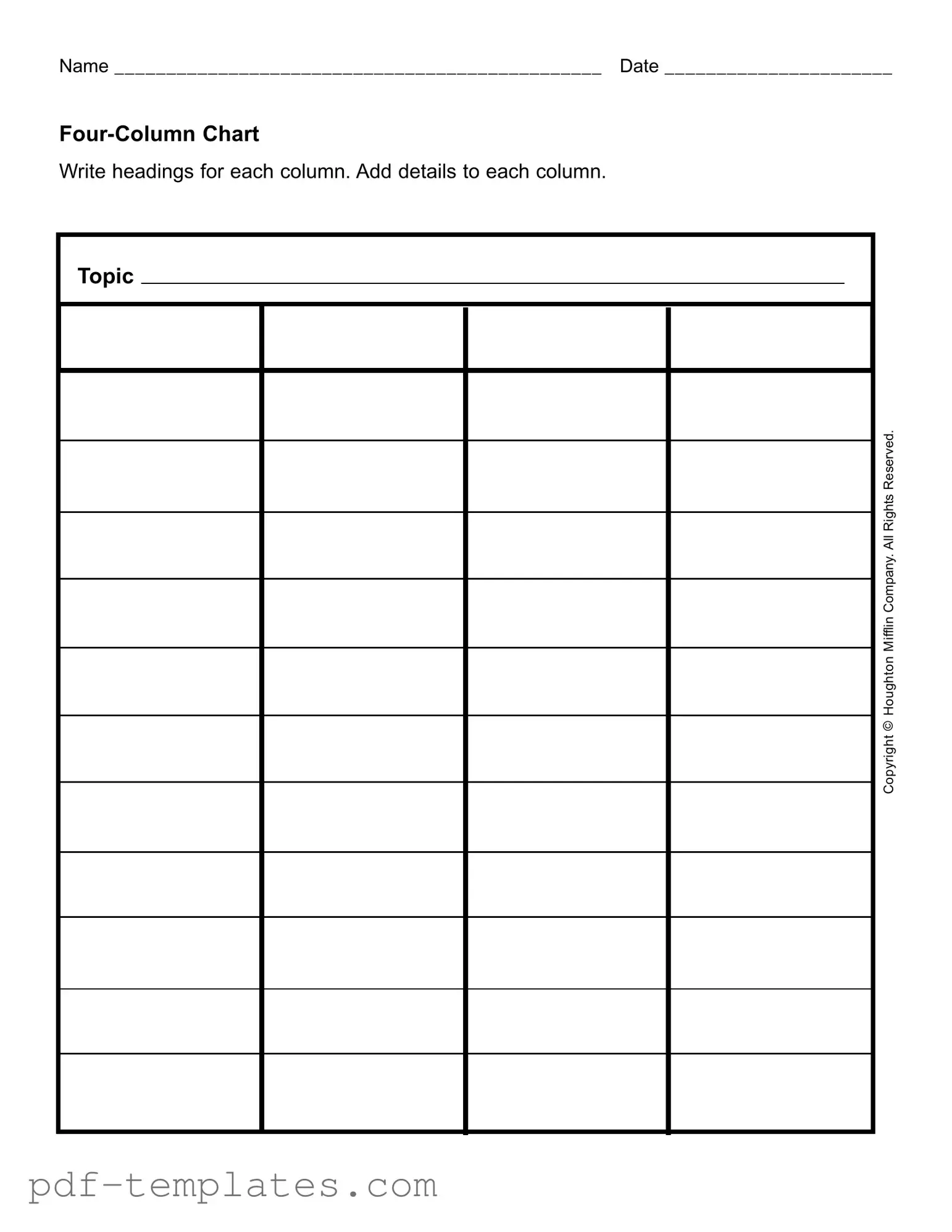The Four Column Chart form shares similarities with the SWOT analysis document. Both tools are designed to organize information clearly and concisely. In a SWOT analysis, individuals identify strengths, weaknesses, opportunities, and threats related to a specific topic or business. Similarly, the Four Column Chart allows users to categorize details under four headings, facilitating a structured approach to understanding a subject. This organization helps in visualizing key points effectively.
The Fishbone diagram, also known as the Ishikawa diagram, is another document that resembles the Four Column Chart. Both are used to analyze problems or processes. The Fishbone diagram visually represents potential causes of an issue, while the Four Column Chart allows for a straightforward listing of details under specific headings. Both formats help users identify relationships between different elements, making it easier to pinpoint areas for improvement.
Mind maps are another tool similar to the Four Column Chart. They provide a visual representation of ideas and concepts, allowing for a free-flowing exploration of a topic. While a mind map branches out from a central idea, the Four Column Chart organizes information into distinct columns. Both methods encourage brainstorming and can lead to a deeper understanding of a subject by breaking it down into manageable parts.
The Venn diagram also shares characteristics with the Four Column Chart. Venn diagrams illustrate relationships between different groups or concepts through overlapping circles. In contrast, the Four Column Chart organizes information into separate columns, but both formats help clarify relationships and distinctions among various elements. This visual representation aids in comparing and contrasting different aspects of a topic.
Flowcharts are another document that bears resemblance to the Four Column Chart. Flowcharts depict processes or workflows in a sequential manner. They guide users through steps or decisions, similar to how the Four Column Chart organizes information into structured categories. Both tools enhance understanding by presenting information in a clear, visual format that can simplify complex ideas.
Checklists also share similarities with the Four Column Chart. Both documents serve as organizational tools that help ensure all necessary information is considered. A checklist allows users to tick off items as they are completed, while the Four Column Chart organizes details under headings for easy reference. Both formats promote thoroughness and can be useful in planning or evaluating tasks.
When dealing with property transactions, understanding the necessary documentation is crucial. For instance, a California Quitclaim Deed form is a legal document used to transfer interest in real estate from one person to another, typically without any warranties regarding the title of the property. This makes it significantly different from other forms of property deeds that guarantee the status of the property's title. It's commonly used among family members or to resolve title issues, providing a swift way to manage property transfers under specific circumstances. For more information, you can refer to All California Forms.
Project management templates can be compared to the Four Column Chart as well. Both tools help in organizing information related to specific projects. A project management template typically includes sections for tasks, deadlines, and responsibilities. The Four Column Chart, while more focused on categorization, also helps in organizing details relevant to a topic or project, facilitating better planning and execution.
Lastly, the Gantt chart is similar to the Four Column Chart in its organizational approach. Gantt charts visually represent project timelines and tasks, showing how different elements relate to one another over time. While the Four Column Chart organizes information into columns, both tools serve to clarify relationships and timelines, aiding in project planning and management.
